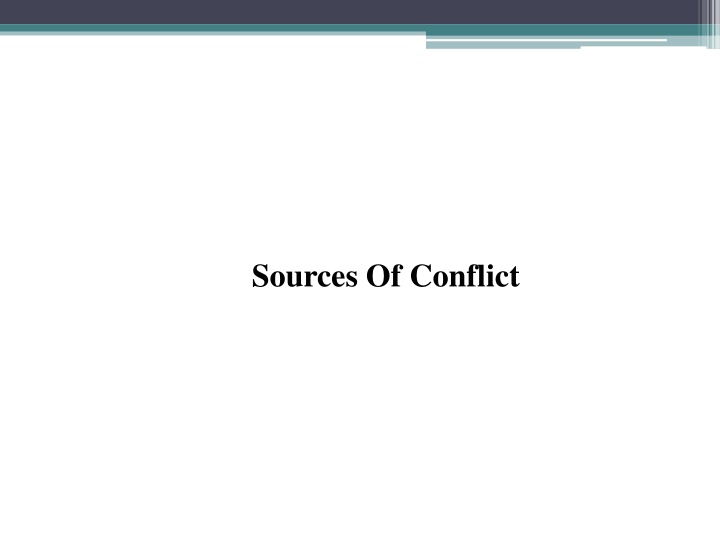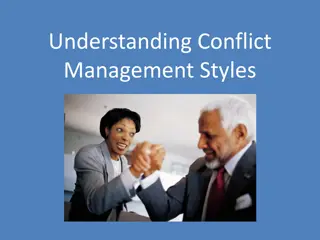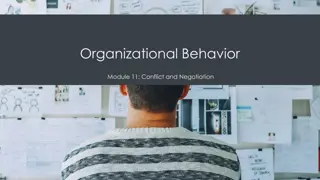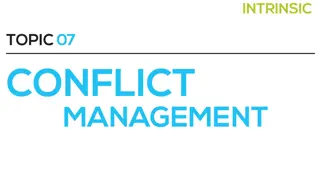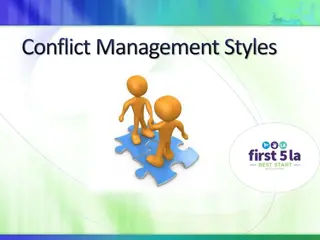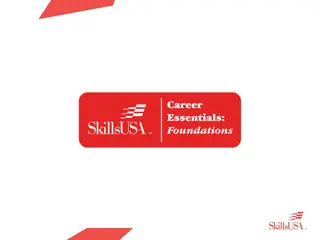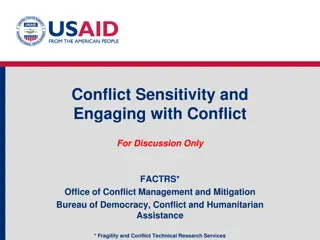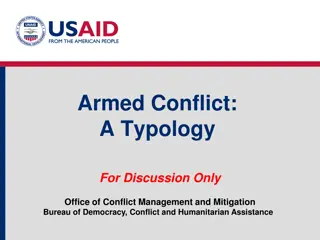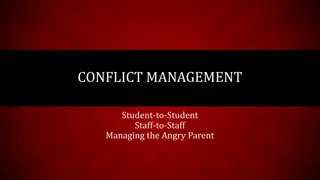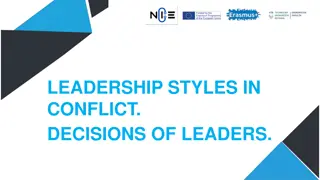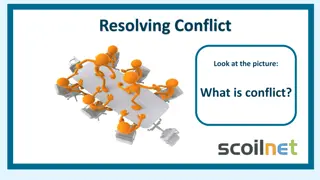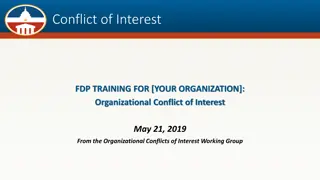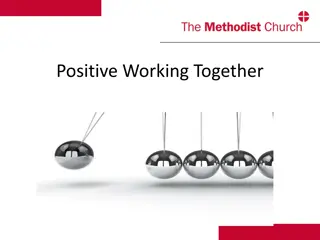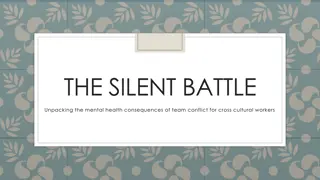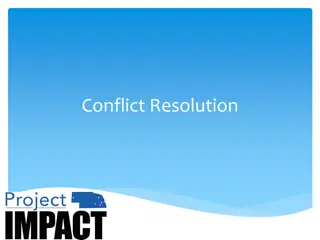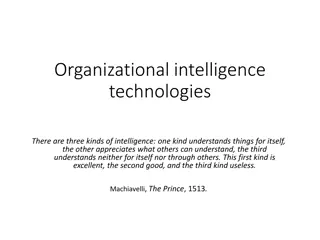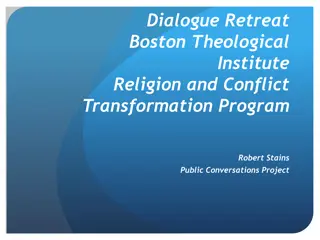Sources of Conflict in Organizational Settings
The antecedents and sources of conflict in organizations is crucial for effective conflict resolution. Incompatible goals, unclear job boundaries, limited resources, inadequate communication, and unresolved conflicts are some common factors contributing to organizational discord. Recognizing these sources can help in managing conflicts proactively and fostering a harmonious work environment.
Download Presentation

Please find below an Image/Link to download the presentation.
The content on the website is provided AS IS for your information and personal use only. It may not be sold, licensed, or shared on other websites without obtaining consent from the author.If you encounter any issues during the download, it is possible that the publisher has removed the file from their server.
You are allowed to download the files provided on this website for personal or commercial use, subject to the condition that they are used lawfully. All files are the property of their respective owners.
The content on the website is provided AS IS for your information and personal use only. It may not be sold, licensed, or shared on other websites without obtaining consent from the author.
E N D
Presentation Transcript
Antecedents of Conflict Certain Situations Produce More Conflict Than Others. Incompatible Personalities or Value System Overlapping or Unclear Job Boundaries Competition for Limited Resources Interdepartment/ Intergroup Competition Inadequate Communication Interdependent task Organizational Complexity Unreasonable or Unclear Policies, Standards or Rules Unreasonable Deadlines or Extreme Time pressure Collective Decision Making Decision Making By Consensus Unmet Expectations Unresolved or Suppressed Conflict
Sources Of Conflict Incompatible goals & time horizons Status Overlapping authority inconsistencies Organizational Conflict Task Scarce resources interdependencies Incompatible evaluation or reward system
Sources Of Conflict Incompatible goals & time horizons Different groups have differing goals and focus. Overlapping Authority Two or more managers claim authority for the same activities which leads to conflict between the managers and workers. Task interdependencies One member of a group or a group fails to finish a task that another member or a group depends on, causing the waiting worker or group to fall behind.
Sources Of Conflict & Use Of Rational v/s Political Model Organization variables When conflict is low Rational model describes organization When conflict is high Political model describes organization Sources of potential inter group conflict Consistent across Participants Goals Inconsistent, pluralistic, Within the organization. Goal incompatibility Centralized Power & control Decentralized, shifting, coalitions & interest groups. Orderly, logical, rational Differentiation Norm of efficiency Decision process Task interdependence Disorderly, result of bargaining & interplay among interests. Extensive, systematic accurate Rules & norms Limited resources Free play of market forces. Conflict is legitimate & expected. Information Ambiguous, information used with held strategically.
Sources Of Conflict Goal incompatibility eg. security and convenience of entry eg. Quality and productivity Differentiation Norms and values (the way things are done) Task Interdependence Output of one group to input of another group Limited resources Budget, information, promotion, use of facilities
Sources Of Conflict Incompatible Evaluation or Reward System A group is rewarded for achieving a goal, but another interdependent group is rewarded for achieving a goal that conflict with the first group. Scarce Resources Managers can come into conflict over the allocation of scare resources. Status Inconsistencies Some individual and groups have a higher organization status than others, leading to conflict with lower status groups.
Managerial Sources Of Conflict Goals (Increase profit margin. Increase efficiency. Capture a bigger market share. Provide better customer service. Improve employee training.), Values, (Service. Social justice. Dignity and worth of the individual. Importance and centrality of human relationships. Integrity. Competence) and Standard () Effectiveness In Communication Treatment Of Subordinates Leadership style
Employee Sources Of Conflict Goals and values Job Requirements (job description and job specification) Competitive Status (abilities of employees) Job Dissatisfaction Personality Clashes Troublemakers Employee conflict may be inevitable, but should never be ignored. Over time, petty grievances can turn to long-standing resentment/ anger/ dislike that affect overall morale and even customer satisfaction. Supervisors and managers should be aware of signs of conflict and address them quickly, bringing workers together to discuss, and resolve, areas of disagreement.
Poor communication is one of the main causes of conflict between employees in the workplace. This can result in a difference in communication styles or a failure to communicate. For example, a manager reassigned an employee s task to the employee s co-worker but failed to communicate the reassignment to the employee. This may cause the employee to feel slighted, which can transform into animosity among the two employees and the manager. Failing to communicate in the workplace may cause employees to make incorrect assumptions and believe workplace gossip. Poor communication in the workplace not only causes conflict but decreases productivity and employee morale. A difference in personalities among employees is another cause of workplace conflict. Employees come from different backgrounds and experiences, which play a role in shaping their personalities. When employees fail to understand or accept the differences in each other's personalities, problems arise in the workplace. For example, an employee may possess a straightforward personality that results in him speaking whatever is on his mind, even if the timing is inappropriate.
The employee with the straightforward personality may offend a co-worker that does not possess the same type of personality. The co-worker may feel as if the employee is rude or lacks the authority to deal with her in such a straightforward manner. Similar to personalities, the values of employees differ within the workplace. A difference in values is seen clearly when a generational gap is present. Young workers may possess different workplace values than older workers. The difference in values is not necessarily the cause of employee conflict in the workplace, but the failure to accept the differences is. When employees fail to accept the differences, co-workers may insult each other's character and experiences. When insults occur, the conflict intensifies until the right solution is offered and accepted. Unhealthy workplace competition is a cause of employee conflict. Some industries foster competitive environments more than others. When salary is linked to employee production, a workplace may experience strong competition between employees. Competition that is not properly managed can result in employees sabotaging or insulting one another, which creates a hostile work environment. Unhealthy workplace competition discourages teamwork and promotes individualism.
Organizational Sources Of Conflict History and traditions. Mission and purpose Culture and climate Goals and values Structures Competitive status. (abilities of employees) Interdependence. Change. Policies
Personality conflict Personality conflict is defined as interpersonal opposition based on personal dislike and/or disagreement What is personality? Personality is the package of stable traits and characteristics creating one s unique identity. The two types of workplace conflicts are when people's ideas, decisions or actions relating directly to the job are in opposition, or when two people just don't get along. In a conflict situation, don t ask who, ask what and why.
Managers should avoid blaming interpersonal conflicts on personality clashes. Such a tactic is an excuse to avoid addressing the real causes of conflict, and the department s performance will suffer as a result. Managers must be able to recognize the signs of conflict behaviors and deal with the conflict in a forthright/direct way or fashion. Approaching conflicts as opportunities to improve departmental policies and operations rather as ailments to be eradicated or ignored will result in a more productive work force and greater departmental efficiency. However, in order to avoid recognizing harsher business bullying situations, employers are more likely to refer to these actions as a personality clash.
How To Deal With Personality Conflict Tips for Employees Having a Personality Conflict Follow company policies for diversity, anti-discrimination. Tips for the Third-party Observers of a Personality Conflict Follow company policies for diversity, anti-discrimination. Tips for Managers Whose Employees are Having a Personality Conflict Follow company policies for diversity, anti-discrimination. Communicate directly with the other person to resolve the perceived conflict (emphasize problem solving and common objectives, not personalities). Do not take sides in someone else's personality conflict. Investigate and document conflict. Suggest the parties work things out themselves in a constructive and positive way. If dysfunctional conflict persists, refer the problem to parties, direct supervisors. If appropriate, take corrective action. Avoid dragging co-workers into the conflict. If necessary, attempt informal dispute resolution. If dysfunction conflict persists, seek help from direct supervisors or human resources specialists. Refer difficult conflict to human resource specialists or hired counselor for formal resolution attempts and other interventions.
Value Conflict: A value is an enduring belief that a specific mode of conduct of end state of existence is personally or socially preferable to an opposite or converse mode of conduct or end state of existence We use the term value to mean "a selective orientation toward experience, implying deep commitment or repudiation, which influences the ordering of choices between possible alternatives in action. preferences in the workplace leading to conflict between supervisors and coworkers . impact that work-value differences have upon the effectiveness and efficiency of job performance. Work-value conflict can occur due to miscommunication, work life balance issues, technology- use differences, and other issues. These personnel problems also include teamwork issues and older worker-younger supervisor relationship difficulties. work-value conflict also affects the effectiveness of organization-wide plans, products, and ideas, competencies, behaviors and attitudes.
Management failure to address work-value differences has been shown to result in low organizational morale, increased turnover, and reduced profits. work environment by which individuals determine/ recognize what is right or wrong and the outcomes they feel they should attain through work . Managers may be influenced to supports their assumptions and change their methods of communication or the structure in their work environment to accommodate employees. Example. Weber characterizes the bureaucratic work setting as one in which a rational organization is ordered by rules, with a high degree of disciplined behavior, an established office hierarchy and clearly defined areas for the power of each office, and appointed specialists to fill these offices. Within such a work structure the employee is expected to be impersonal in his relations with other employees and with clients or customers, to put loyalty to the company ahead of other loyalties, and to value the external motivators of status and achievement above the rewards of interpersonal relations.
Value System: Value system is defined by Rokeach as an enduring organization of beliefs concerning preferable modes of conduct or end state of existence along a continuum of relative importance
Instrumental Values: Instrumental values are alternative behaviors or mean by which we achieve desired ends. Sample instrumental values from Rokeach s original list are ambitious, honest, independent, loving, and obedient.
Terminal Value: Are desired end-states or life goals Such as a sense of accomplishment, happiness, pleasure, salvation/ recovery/ deliverance and wisdom. Some would say terminal values are what life is all about.
Intergroup Conflict: It is a type of behavior which results from an interaction between two or more groups (Litterer,1966) and which manifests itself in disagreement, differences, or incompatibility (Rahim, 1985) often some threat to the group must be perceived for conflict to occur (Stein, 1976).
The Seeds Of Inter-group Conflict Cohesive sense of weness binds group together togetherness can be a good or bad thing. Cohesiveness creates team work. Cohesiveness pushes aside critical thinking. Package of changes associated with increased cohesiveness. Members of in-group, view themselves as a collection of unique individuals, while they stereotype members of other groups as being allalike . In-group members see themselves positively and as morally correct, while they view members of other groups negatively and as immoral. In-groups view outsides as a threat. In-group members exaggerate between their group and other groups. This typically involves a distorted perception of reality.
How To Minimize Inter-group Conflict Cross group interaction members of different groups join one group. Work to eliminate specific negative interactions between group members personality conflict. Conduct team building to reduce intra-group conflict and prepare employees for cross-functional team work. Encourage personal friendship and good working relationships across groups and departments. Foster positive attitudes towards members of other groups.
Conflict Between Organization And Environment Conflict that arises between one organization and another is called inter-organizational conflict Cross-cultural Conflict Culture is defined as the shared set of values, beliefs, norms, attitudes, behaviors, and social structures that define reality and guide everyday interactions Dimensions Of Culture a. Individualistic Cultures b. Collectivist Cultures
Part 2 Recognizing Behaviour For Conflict Management
Assertiveness Assertiveness is the process of expressing feelings, asking for legitimate changes, and giving and receiving honest feed back
Assertive Behavior that maintains self respect while respecting the rights of others: Standing up for rights and needs Honest, effective communication Workable compromise Appropriate affect I win, you win
Bill Of Assertive Rights I have the right to: 1.Judge my motivation (but not other s) 2.Decide whether to take on added responsibilities 3.Make mistakes and change my mind if I", make it right 4.Not to live in fear (but not cause others to live in fear) 6.Be treated with respect (but not treat others disrespectfully) 7.Express my feelings/opinions and allow others the same 8.Be taken seriously (but need to take others seriously) 9.Privacy without being gossiped about (but not gossip myself)
Characteristics Of Assertive Behavior Own ideas, thoughts, and feelings Describe behavior and feelings Maintain regular eye contact and a self-confident posture Use a firm but pleasant tone of voice Speak fluently Be sensitive to the face needs of others
Behavioral Indicators of Assertiveness Eye contact Body posture Gestures Facial expressions Voice tone Follow-through on agreements Message content
Aggressive Behavior Hostile or coercive words or actions that communicate disrespect towards others constitute aggressive behavior.
Aggressive Behavior that is manipulative, contains inappropriate expressions of anger and violates the other person s rights: Overpowering Frightening Degrading Humiliating I win, you lose
Passive Behavior This involves failing to express our wants, needs or feelings or communicating them in an indirect or apologetic way.
Passive Behavior that violates one s own rights by failing to express honest feelings and needs openly or by expressing needs in a shy/self-effacing, self-degrading way: Apologetic Weak Helpless Victim Unimportant I lose, you win
Passive/Aggressive Behavior that expresses anger in a hidden way from the recipient and from the P/A person but becomes apparent through behavior: Being late Not completing agreements Didn t mean to do it Creates upset covertly I win, you lose (indirectly)
Accommodating or Smoothing The accommodating approach emphasizes cooperation instead of assertiveness. A person places his interests last and allows the other party to further her interests. The accommodating approach often occurs when a party is not significantly invested in securing a victory, because he does not perceive the alternative option as a significant threat. Low on assertiveness, but high on cooperation an accommodating approach is used by managers who want to appear reasonable in their decision-making. Managers using this style demonstrate that they are peacemakers, willing to yield where possible and want to create goodwill with all. But too much accommodation and managers risk appearing weak, indecisive and not willing to embrace change. Embracing flexibility once issues have been clearly and concisely defined can strengthen a manager's position. Unassertive and cooperative The opposite of competing Neglecting your own concerns in order to satisfy the concerns of another
Could take the form of selfless generosity, obeying an order when you would prefer not to, or yielding to another s point of view Accommodating is also known as Smoothing, the concerns of other people first of all, rather than one's own concerns. Examples of when smoothing may be appropriate: When it is important to provide a temporary relief from the conflict or buy time until you are in a better position to respond/push back When the issue is not as important to you as it is to the other person When you accept that you are wrong When you have no choice or when continued competition would be detrimental Possible advantages of accommodating or smoothing: In some cases smoothing will help to protect more important interests while giving up on some less important ones Gives an opportunity to reassess the situation from a different angle
Some warnings of accommodating or smoothing: There is a risk to be abused, i.e. the opponent may constantly try to take advantage of your tendency toward smoothing/accommodating. Therefore it is important to keep the right balance and this requires some skill. May negatively affect your confidence in your ability to respond to an aggressive opponent It makes it more difficult to transition to a win-win solution in the future Some of your supporters may not like your smoothing response and be turned off o In Giving in or accommodating the other party requires a lot of cooperation and little courage. Basically, you agree to accommodate the other party by acknowledging and accepting his point of view or suggestion. This style might be viewed as letting the other party have his way. While this style can lead to making peace and moving forward, it can also lead to the accommodator feeling resentment toward the other party.
Emphasizing areas of agreement To reach an overarching goal To maintain harmony When any solution will be adequate When you will lose anyway To create goodwill
Avoiding or Withdrawing Avoiding conflict involves one of the conflicted parties avoiding communicating about or confronting the problem, hoping it will go away. Avoiding or withdrawing from a conflict requires no courage or consideration for the other party. By avoiding the conflict, you essentially pretend that it never happened or doesn t exist. Some examples of avoidance or withdrawal include pretending there is nothing wrong, stonewalling or completely shutting down. By not participating in the problem-solving process, she is effectively removing herself from it. When employing this approach, the conflict might go away if the other party doesn't press for a resolution. The underlying differences between the parties are never resolved. Managers who don't want to handle conflict are likely to avoid it altogether. This approach dismisses the manager's own concerns and those of the other individual, leaving the conflict unresolved. Sometimes this approach is useful when a problem should be addressed at another time or if a threatening situation surfaces. Overuse of this approach and problems will continue to intensify, perhaps erupting or at least thwarting honest communication.
There are three reasons why the avoidance approach is taken: (1) exposing oneself to ridicule or rejection, (2) recognizing we may have contributed to the problem and (3) willingness to change. Unassertive and uncooperative Pursuing neither your own concerns or those of your opponent Not addressing the conflict Could take the form of sidestepping an issue, postponing the resolution of a conflict, or withdrawing from a threatening situation
Withdrawing is also known as avoiding. This is when a person does not pursue her/his own concerns or those of the opponent. He/she does not address the conflict, sidesteps, postpones or simply withdraws. Examples of when avoiding or withdrawing may be appropriate: When the issue is trivial and not worth the effort When more important issues are pressing, and you don't have time to deal with it In situations where postponing the response is beneficial to you, for example - When it is not the right time or place to confront the issue When you need time to think and collect information before you act (e.g. if you are unprepared or taken by surprise) When you see no chance of getting your concerns met or you would have to put forth unreasonable efforts When you would have to deal with hostility When you are unable to handle the conflict (e.g. if you are too emotionally involved or others can handle it better)
Possible advantages of Avoiding: When the opponent is forcing / attempts aggression, you may choose to avoid or withdraw and postpone your response until you are in a more favourable circumstance for you to push back Avoiding or Withdrawing is a low stress approach when the conflict is short Gives the ability/time to focus on more important or more urgent issues instead Gives you time to better prepare and collect information before you act Some warnings of Avoiding May lead to weakening or losing your position; not acting may be interpreted as an agreement. Using withdrawing strategies without negatively affecting your own position requires certain skill and experience When multiple parties are involved, avoiding or withdrawing may negatively affect your relationship with a party that expects your action.
Collaborating The collaboration style involves parties working together to resolve issues, and both sides come to the table with win-win attitudes. It is a favorable negotiation style in formal dispute resolution situations, such as mediation, where the parties employee a mediator but must agree on the final, binding resolution. In a spirit of demonstrating unity, managers may choose to collaborate by showing a high degree of assertiveness and cooperativeness. This win-win approach is favored when both sides have important differences, but to get the job done everyone agrees to work together. Considered time consuming, a collaborating approach can mean that one party is being taken advantage of while insignificant matters are given considerable attention and personal responsibilities are ignored. Collaboration plays a major role within conflict resolution and requires great courage and much consideration. Collaborating with the other party involves listening to their side, discussing areas of agreement and goals, and ensuring that all parties understand each other. Collaboration requires thinking creatively to resolve the problem without concessions. Collaborators are usually admired and well-respected.
Assertive and cooperative The opposite of avoiding Attempting to jointly work toward a solution that fully satisfies the concerns of all involved Digging into an issue to identify and address the underlying concerns of all parties involved Collaboration involves an attempt to work with the other person to find a win-win solution to the problem in hand - the one that most satisfies the concerns of both parties. The win-win approach sees conflict resolution as an opportunity to come to a mutually beneficial result. It includes identifying the underlying concerns of the opponents and finding an alternative which meets each party's concerns. Examples of when collaborating may be appropriate: When consensus and commitment of other parties is important In a collaborative environment When it is required to address the interests of multiple stakeholders When a high level of trust is present When a long-term relationship is important When you need to work through hard feelings, animosity, etc When you don't want to have full responsibility
Possible advantages of collaborating: Leads to solving the actual problem Leads to a win-win outcome Reinforces mutual trust and respect Builds a foundation for effective collaboration in the future Shared responsibility of the outcome You earn the reputation of a good negotiator For parties involved, the outcome of the conflict resolution is less stressful (however, the process of finding and establishing a win-win solution may be very involved) Some warnings of collaborating: Requires a commitment from all parties to look for a mutually acceptable solution May require more effort and more time than some other methods. A win-win solution may not be evident For the same reason, collaborating may not be practical when timing is crucial and a quick solution or fast response is required Once one or more parties lose their trust in an opponent, the relationship falls back to other methods of conflict resolution. Therefore, all involved parties must continue collaborative efforts to maintain a collaborative relationship.
Compromise Bargaining is the hallmark of the compromise approach to conflict resolution. The conflicting parties can identify some interests they are willing to compromise on to bring about a resolution. While the emotional level might still be high, the compromise style sometimes results in interim solutions when a full resolution is not immediately possible. Parties might reach a settlement to prevent further escalation of the conflict. Moderately cooperative and assertive, a compromising approach to conflict resolution finds a mutually acceptable solution. A middle ground has been found, one where both parties can stake a claim to victory. Too much compromise and you may come across as someone who has no firm values; too little compromise leads to further power struggles and confrontations. Compromising is a big step toward conflict resolution. Both courage and consideration are used when both parties look for common ground. You agree to negotiate larger points and let go of the smaller points; this style expedites the resolution process. Occasionally, the person compromising might use passive- aggressive tactics to mislead the other party, so beware.
Compromising looks for an expedient and mutually acceptable solution which partially satisfies both parties. Examples of when compromise may be appropriate: When the goals are moderately important and not worth the use of more assertive or more involving approaches, such as forcing or collaborating To reach temporary settlement on complex issues To reach expedient solutions on important issues As a first step when the involved parties do not know each other well or haven t yet developed a high level of mutual trust When collaboration or forcing do not work Possible advantages of compromise: Faster issue resolution. Compromising may be more practical when time is a factor Can provide a temporary solution while still looking for a win-win solution Lowers the levels of tension and stress resulting from the conflict Some warnings of using compromise: May result in a situation when both parties are not satisfied with the outcome (a lose-lose situation) Does not contribute to building trust in the long run May require close monitoring and control to ensure the agreements are met.
